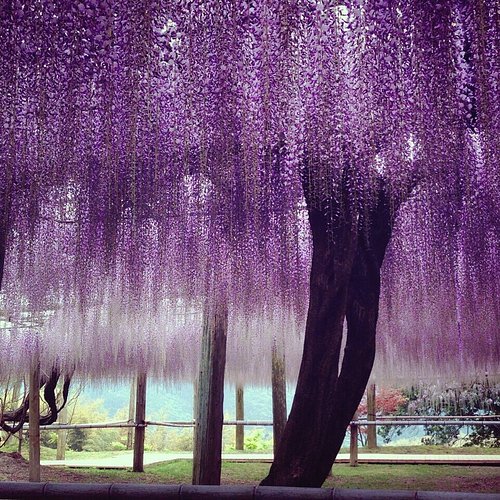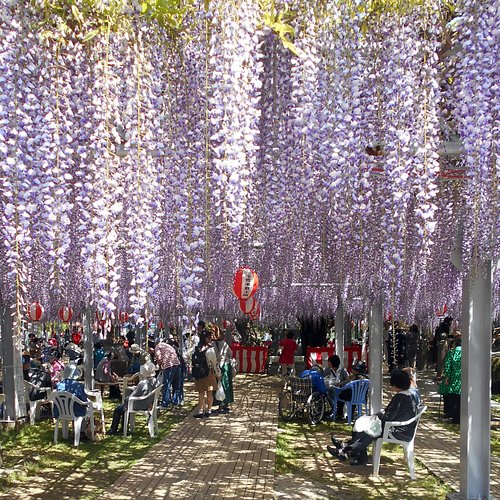What to do and see in Fukuoka Prefecture, Kyushu-Okinawa: The Best Cultural Events
1. Kitakyushu City Kawachi Fuji Garden Wisterias Blossom
Overall Ratings
4.5 based on 241 reviews
In the spring, the Kawachi Fuji Gardens open their Wisteria tunnels to the public. Wisteria, lauded in Japanese poetry, bloom strongest between April and May. The Kawachi Fuji Wisteria are especially lovely, as the hundred-year old trees are arranged to blossom around domes and trellises, with clusters of flowers hang down in delicate rows, leaving only patches of streaming sunlight in between. The magical sight attracts visitors from all over the world. Over twenty species of Wisteria compose the two main tunnels, one 260 feet long, and the other 720 feet long. Each features an explosion of petals from lavender to deep royal purple, with bursts of pink, blue, and white in between.
Reviewed By kimitakas - Taichung, Taiwan
Kawachi Wisteria Garden is one of highlights for the sightseeing in Kitakyushu. The season is at the end of April and the beginning of May. To avoid the crowds, you should obligatorily book an entrance coupon at convenience store. On a less crowded day, that coupon is used as an entrance ticket. For a crowded day, you have to pay an extra fee at the entrance gate in addition to that coupon. To access the site, the most convenient is driving a car. Otherwise, you can take a public bus from JR Yahata station, and walk about half an hour. It is not bad, and even recommendable to walk, because the way to wisteria park is a very pleasant promenade.
2. Kitakyushu City Kawachi Fuji Garden Autumn Colors
3. Hakata Gion Yamakasa
Overall Ratings
4.5 based on 86 reviews
Held annually between July 1st and 15th, this is one of Hakata's signature festivals, along with Hakata Dontaku. There are various opinions concerning its origin, but many believe it started in 1241 when the monk Shoichi Kokushi sprinkled holy water to get rid of diseases. For this festival, floats similar to portable shrines called yamakasa are built up high with countless banners and dolls. For safety, the shoulder-carried floats called kaki yamakasa used for transporting people are three meters high. On the first day, cordoning ropes are dropped (a cleansing event in the style of the region) and the ritual of inviting deities into the yamakasa begins. On the 10th, the floats finally start their parade called the nagare kaki, and the festival really heats up.
4. Yanagawa Dolls’ Festival Sagemon Meguri
Overall Ratings
4.5 based on 33 reviews
Sagemon is a decorating custom originating in Yanagawa, Fukuoka Prefecture expressing a wish for sound health and decent suitors for girls. Red and white cloths are wrapped around bamboo rings to make seven ornaments each with seven strings, and then placed around two Yanagawa balls in the center. This total of 51 decorations signifies an old tradition of wishing for one more year of life when a normal life span was thought to be 50 years. The Yanagawa Dolls' Festival Sagemon Meguri is held from February to April, during which a number of events take place, including a doll festival, aquatic doll parade, and a festival in which paper dolls are floated down the river.
5. Nakayama Oto Festival
6. Fukuoka Castle Cherry Blossom Matsuri
Overall Ratings
4.5 based on 38 reviews
Maizuru Park is the former site of the Fukuoka Castle inner citadel, which bears a connection to Kuroda Yoshitaka. In spring, the Yoshino cherry trees and weeping cherry trees burst into bloom -- close to 1,000 of them -- and the Fukuoka Castle Cherry Blossom Matsuri is held from late March through early April. During the event season, a signal gun inspired by Kuroda's unique cannonry marks the start of the nightly illumination show. There is also a quiz rally held at the Korokan at Fukuoka Castle, exclusive openings of the Sakura Fureai Zoo, and other programs. Lastly, the Ohori Festival is a historical reenactment of a march of Kuroda's horsemen.
7. Hakata Dontaku
8. Kurume Azalea Festival
Overall Ratings
4.0 based on 16 reviews
A shrubbery festival considered to be among Japan's three finest. (The other two being in Kumamoto and Kanuma). There are, of course, Kurume azaleas, and also potted plants, flowers and shrubs, and ornamental trees for sale. There are also exhibits of model gardens and bonsai plants. Also held are workshops and events on repotting azaleas and orchids, crafting lichen balls, and mini bonsai planting. The charity auction has been a popular favorite each year and leads to some wild bids.
9. Kawatari Jinko Festival
Overall Ratings
4.0 based on 8 reviews
One of Fukuoka Prefecture's finest five festivals, this one is held on the third Saturday of May each year. It is believed to trace its roots to an offering of thanks being performed in repayment to Fujihachimangu, the site of the patron deity of the area, after an illness was cured through prayer. Boasting 450 years of history, this was designated the first important intangible folk culture asset of the prefecture in 1970. For the festival, the deity makes a once-yearly ride in the sacred palanquin and is taken to the other side of the river, with floats in each area following along and recreating the story. In the afternoon, impressive floats cross the Hikosan River, and in the evening, they emerge with lights illuminating them.
10. Kurume Matsuri
Overall Ratings
4.0 based on 14 reviews
This summer festival was launched in 1972 by the residents of Kurume. On the eve of the festival, a hula dance and other stage events are held starting at dusk at the Kurume Higashimachi Park, with a proclamation announcing the start of the festival taking place at night, as well as a raffle. For the second day, the festival takes flight, and Meiji-dori becomes a pedestrian paradise called the "Power Street," with carnival events and taiko drum performances exciting the crowd. In the evening, there is a group so-odori dance of 10,000 people. The festival for that day concludes with a grand finale of ladder-top stunts, and the finishing climax is the "water illumination." Jets of mist are illuminated with light and enhance the Chikugo River. The final day features a large fireworks show over the Chikugo River.









